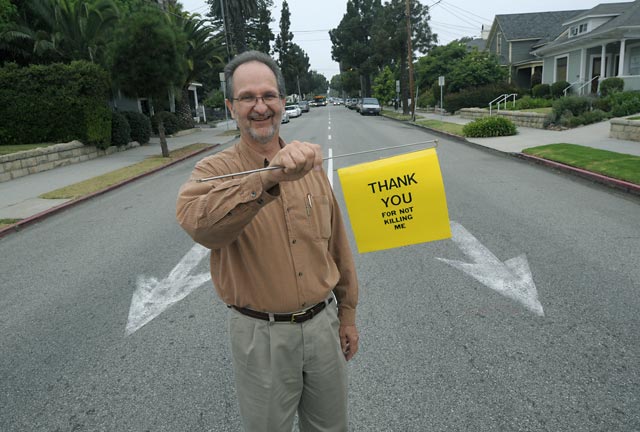Flags Up for Pedestrian Safety
Cost: About $200 per Intersection

Amid all the flying spittle and bitter controversy over bulb-outs and other traffic safety improvements to the City of Santa Barbara’s troubled streets, and in a time of seemingly skyrocketing crosswalk injuries to pedestrians, one simple, effective, and increasingly popular solution has been overlooked. Cities in Japan and throughout the U.S. have adopted the crossing flag approach, saving lives and lots of money. It’s time our City Council put down the hatchets and looked into this system.
A crossing flag system is simple. A small metal or plastic bin is attached to a pole on each corner of the intersection. Several brightly colored plastic flags are placed in each bin. A decal or small sign explains how to use the flags. The idea originated in Japan, and was first adopted in the mid-1990s by the City of Kirkland, Washington. Since then it has spread to Seattle and some other Washington cities, as well as to Salt Lake City, Utah; a couple of cities in Wisconsin; Buffalo, New York; and Burlington, Vermont, among others.
How does it work? You grab a flag, hold it confidently out in front of you, wait until oncoming traffic stops for you, and then cross the street. Put the flag in the bin on the far side of the street when you get there. That’s it.
It’s so effective that systems are popping up all over the United States. Traffic officials in Salt Lake City observed, “City staff has noted a dramatic increase in the willingness of drivers to yield to pedestrians carrying orange flags…[J]ust having the flags sitting in their holders raises motorist awareness of pedestrians by making the crosswalk locations more visible.”
Most cities that have tried the flag approach have kept it going and steadily added intersections to the program. Salt Lake City has flagged 174 intersections, Seattle 23 to date, and Kirkland, Washington 73. Kirkland, by the way, has one of the lowest pedestrian death rates in the United States; they’ve produced a video that can be seen on YouTube.
A 2006 study by the National Cooperative Highway Research Program sponsored by the Federal Transit Administration [PDF is here] stated that, “The research team found no formal studies in the literature on the effectiveness of crossing flags; however, anecdotal information has indicated that these crossing flags are effective in improving driver yielding behavior.”
Flagging an intersection costs around $200. Keep in mind that the City is pondering whether to spend $326,000 to equip just one dangerous intersection with safety improvements, and you can see that this is a dirt-cheap way to go. The flags, which cost $2 to $3 to replace, tend to disappear; many communities enlist neighboring businesses or residents as adopters of the intersection and they replace flags as needed. In Menomonie, Wisconsin, the flags are removed at night to reduce theft and vandalism. But of course, $325,800 will buy a lot of replacement flags.
The City should also consider the possibility of simply distributing pocket-sized flags to all residents and making them available to visitors at their hotels. This would eliminate the theft problem, raise awareness of pedestrian safety issues, reduce maintenance costs to zero, and make every intersection a flagged intersection at no additional cost to the community. Distributing 100,000 flags would cost less than equipping one intersection with traffic signals or bulb-outs. (I made a prototype version of a telescoping flag out of a discarded television antenna and a bit of yellow material for under a dollar.) Imagine every citizen packing his or her own personal traffic calming device. Imagine yourself as a pedestrian being in control of oncoming traffic for a change. Imagine a safer community at very little cost.
What do you think, City Council? Do you want to waste time and money bickering over enormously expensive solutions to this problem, or do you want to solve it for a pittance? A test system could be in place at Figueroa and De la Vina Streets within a week. Why not give it a try?



